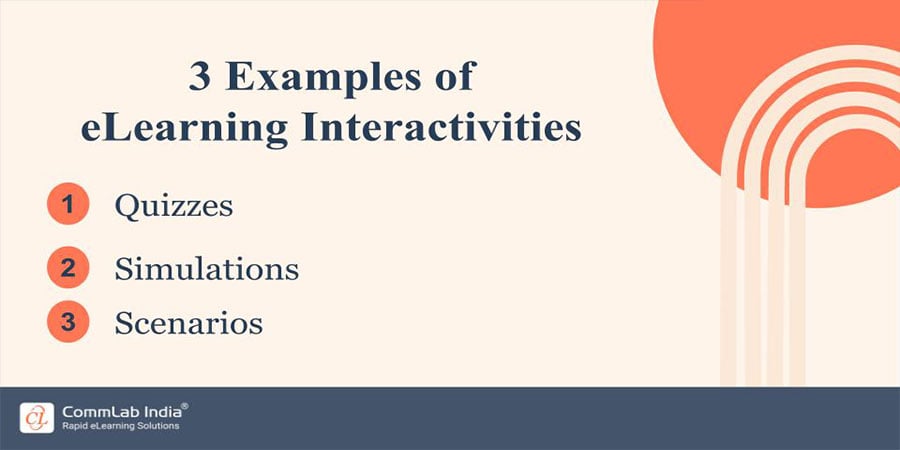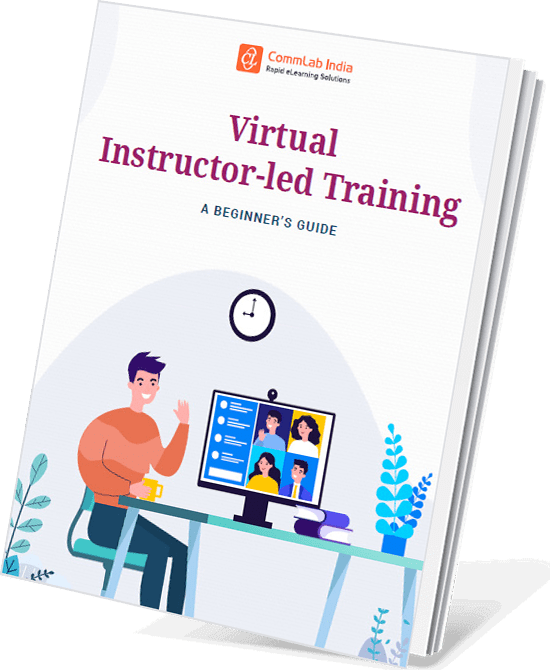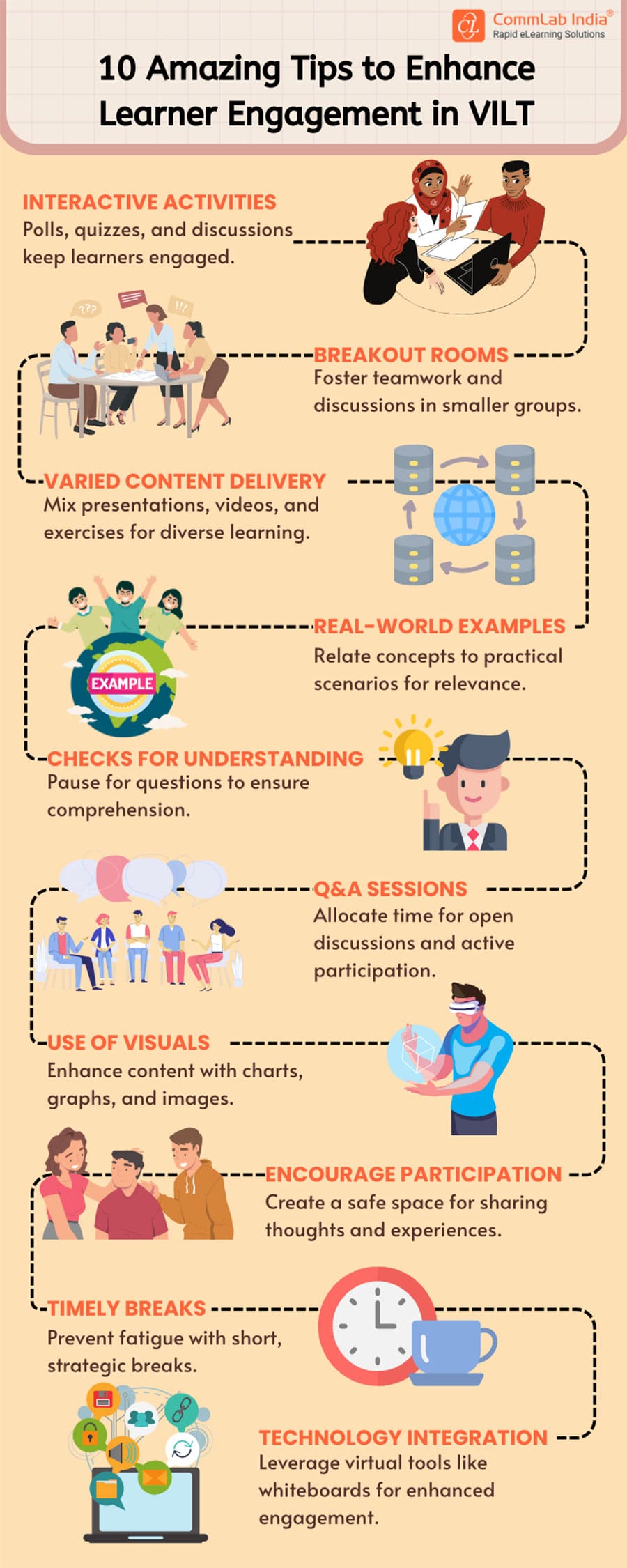Hook your Learners: Secrets to Better Virtual Instructor-led Training

Designing Virtual Instructor-led Training (VILT) courses effectively is not an easy task. But that doesn’t mean you should stop trying. Rather it means that you need to put your best foot forward by paying close attention to the important elements of a VILT program. They help you design high-impact, learner-centric virtual training experiences.
→ Download Now: Virtual Instructor-led Training – A Beginner’s Guide
Table Of Content
Top Things to Keep in Mind While Designing VILT
- Understand Your Learners
- Set Clear Learning Objectives
- Create Engaging Content
- Keep the Training Material More Relevant
- Add Interactivities
- Encourage Collaboration
- Provide Timely Breaks
- Reward Good Performance
- Ensure Mobile Compatibility
- Select the Right Virtual Platform
Top Things to Keep in Mind While Designing VILT
Designing VILT is Easy Now!
Here are 10 Things to Remember:
- Understand Your Learners
- Set Clear Learning Objectives
- Create Engaging Content
- Keep the Training Material More Relevant
- Add Interactivities
- Encourage Collaboration
- Provide Timely Breaks
- Reward Good Performance
- Ensure Mobile Compatibility
- Select the Right Virtual Platform
1. Understand your Learners
Understanding your learners is a fundamental aspect of designing effective VILT program. That’s right! This element involves identifying the target audience and understanding their specific learning needs. In turn, it lays the foundation for creating relevant and engaging corporate training material. But how can you understand the learners? Well, you can conduct a thorough needs analysis, along with other factors like demographics, learners’ prior knowledge, their skills, as well as learning preferences.
Moreover, understanding your learners also includes assessing their technical proficiency and familiarity with virtual training platforms. It plays an integral role in tailoring the VILT program according to learners’ specific requirements for maximum impact. It helps you in identifying the potential barriers and allows you to provide additional training resources or tutorials to support the learning of your employees.
And that’s not all! Being well-versed with your target audience enables you to select relevant instructional design strategies that accommodate diverse learners and foster learner engagement. For this, you should pay attention to different learning styles, language proficiency, cultural backgrounds, accessibility needs, etc. It creates a more inclusive learning environment.
2. Set Clear Learning Objectives
Setting goals in your virtual classroom should be one of the top priorities to make your virtual instructor-led training more efficient and impactful. What is expected from the learners? What can the learners do from the virtual training session? Answering these questions at the beginning will establish a code of conduct within your virtual classroom.
Not only is it important to set these goals, but you should also focus on making them clear. Use simple language and try to be as direct as possible. For instance, you can establish rules that the learners can note down their questions and ask them before the session is closed. Or you may emphasize upon participating in the games or quizzes organized during the virtual training session.
Discover how clear learning objectives can transform your corporate training programs and boost effectiveness.
3. Create Engaging Content
Pick one: A lengthy text or an interactive eBook.
I’m sure, most of us have opted for the second one, i.e., an interactive eBook. Your learners are no exception! It is a well-known fact that interactive, engaging training content delivers more effective, desirable results. Therefore, it is a vital component in designing VILT programs too. To ensure interactivity and engagement in your training material, it is important that you strike a balance between presenting relevant content and choosing the right instructional design strategy, along with other multimedia elements and eLearning interactivities.
To begin with, define your learning objectives and outcomes clearly. Based on this, create a clear, concise roadmap for your learners. It will help you design content that is focused, relevant, and aligned with the desired learning outcomes, thereby making it more engaging and interesting for the learners.
Furthermore, you can leverage different multimedia elements to augment the learning experiences in VILT programs. This can include videos, infographics, audio, digital flashcards, etc. eLearning interactivities are another great way to grab the attention of your learners and foster active participation.
Here are a few examples of eLearning interactivities.

You can also design training content that offers opportunities to collaborate. It promotes engagement and coordination among learners. Well, engagement isn’t just limited to training sessions. It must be very well carried forward to eLearning assessments as well. So, you can use quizzes, MCQs, match the following, group discussion, etc., to evaluate the understanding of your learners. Overall, all these elements collectively form the basis for designing effective VILT programs that result in meaningful and impactful learning experiences.
4. Keep the Training Material More Relevant
It is important that your employees see that the VILT approach were created to help them solve challenges and perform better – otherwise would make them lose their interest! So, if you want your employees to be more productive and involved in the VILT programs, you will have to see that the training content is relevant to them.
Research your target audiences, their educational backgrounds, their current skills, training needs and expectations, and their ages. Along with the learners’ analysis, assessing the learning environment will also help in gathering information so that the learning experience can be personalized and the content can be made more relevant.

Virtual Instructor-led Training – A Beginner’s Guide
Explore the Art and Science of Replicating the Real Classroom, Virtually
- Pillars of VILT
- Instructional strategies in VILT
- Tips to engage virtual learners
- Technology platforms for VILT
5. Add Interactivities
The absence of human interaction in a virtual classroom setting can lead to the employees becoming distracted in the virtual classroom. The best way to capture their attention is by introducing interactivity during the virtual training sessions. Adding learning interactivities to your VILT programs will not only encourage their participation but will also boost productivity.
Want to make your VILT sessions more engaging? Check out our infographic on adding interactive learning elements for a better experience!
6. Encourage Collaboration
Virtual learning activities that give room for collaboration and teamwork are not just fun and engaging, they also help with team building. Encouraging your employees to work as a team to achieve a specific eLearning goal will work as an engaging factor that also encourages high participation levels. This will ultimately boost their productivity in the training session.
For this, you could be considering online collaborative activities such as chats, polls, and breakout rooms. Including these activities in VILT encourage learners to work together to achieve shared objectives, stimulates knowledge exchange, and encourages them to coming up with unique solutions for the work challenges.
7. Provide Timely Breaks

Ralph Marston’s quote is a great reminder to take breaks. It emphasizes the importance of rest and rejuvenation. With that said, in your virtual instructor-led training session, providing breaks offers your learners the opportunity to pause, recharge, and revitalize their engagement with the training content. Such intentional intermissions not only ensure cognitive refreshment but also boost physical comfort and interaction.
Therefore, while designing the VILT programs, make sure to incorporate breaks in a well-planned manner for a balanced, learner-centric corporate training experience.
8. Reward Good Performance
Employees who strongly agree that recognition is an important part of their organization's culture are 3.7 times more likely to be engaged at work.
Source: Forbes
Recognition is one of the best motivators that not only boost morale but also encourage better performance and increased engagement. One of the best ways to use this motivator in virtual corporate training is by creating some engaging learning activities/exercises that recognize and reward good performance.
By rewarding them, with scores and points, or gifting as a token of appreciation, for instance, for their accomplishments, you can show your employees that you value their professional development and aspirations. At the same time, you will also make them feel valued for contributing to the company’s success. Be it for freshers, or experienced ones, rewards, and recognition both serve as motivators for learner engagement show them they can make a difference throughout their virtual training, and they will want to prove you correct on a regular basis once they have finished it. This will ultimately boost their productivity.
9. Ensure Mobile Compatibility
Let me state the obvious – If your virtual training is not accessible and user-friendly, then the whole effort goes south! The virtual training is meant to be mobile-friendly and user-friendly. Remember that mobile optimization is not just an option! It is now a necessity – thanks to mobile learning outnumbering desktop learning!
Considering this, it is important that you make mobile compatibility a priority when developing content and features for your virtual instructor-led training.
Discover how mobile learning is revolutionizing corporate training and transforming the way employees learn anytime, anywhere.
10. Select the Right Virtual Platform
You wouldn’t attempt to cross the ocean on a bicycle. Would you? Similarly, it is equally important to select the right platform for facilitating the VILT course. Your selection of the virtual platform is intricately woven with how you design your VILT courses. After all, the VILT platform you choose serves as the sturdy vessel to carry your course content, facilitate meaningful interactions, and ensure a smooth learning experience.
And a word of caution here is that not all the virtual training platforms would support the design and format of your VILT courses. So, when you embark on your decision-making journey toward selecting the right platform, consider the features and functionalities that will navigate you toward success. Make sure they align with your course requirements and support the design of your VILT course.
From live video conferencing to breakout rooms that ignite collaboration, the virtual platform is the key. With that said, design the courses in a way that aligns with the platform’s device compatibility and accessibility needs. Along with this, make sure it follows the policies and guidelines of the virtual platform to facilitate an effective and seamless learning experience for your learners.
Wrapping Up!
Evidently, designing virtual instructor-led training calls for careful planning and implementation. Combining both these elements helps ensure a holistic, positive virtual training impact. Effectively designed VILT programs allow the learners to furnish their skills and enhance their knowledge which further augments their performance and productivity. Moreover, this paves the way for maximum corporate training ROI. And now you already know the things to keep in mind to design VILT programs in an effective manner. So why miss a chance to create learner-centric, impactful VILT sessions? Get started right away! If you’re just taking baby steps, then given below is a beginner’s guide on virtual instructor-led training. Check it out now!





![5 Benefits of Blended Learning That Will Transform Your Corporate Training [Video]](https://blog.commlabindia.com/hubfs/Imported_Blog_Media/blended-learning-benefits-corporate-training-video.jpg)

